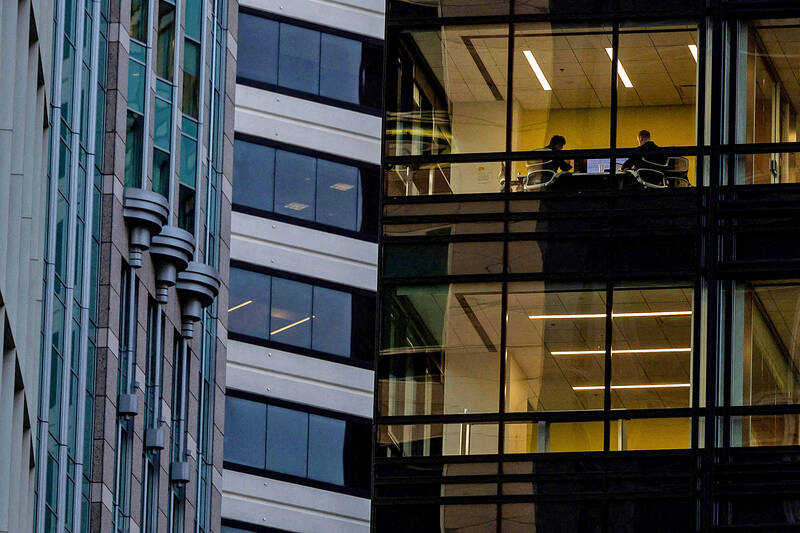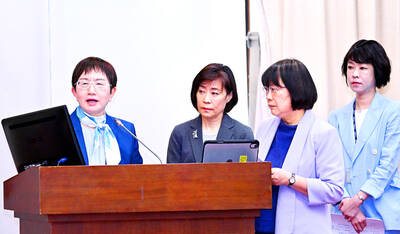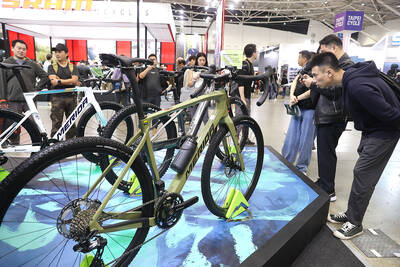A US banking giant fired more than a dozen employees for “simulating keyboard activity,” highlighting a battle within productivity-obsessed corporate America to tame a culture of faking work with gizmos such as mouse jigglers.
The sackings by Wells Fargo & Co come as employers use sophisticated tools — popularly called “tattleware” or “bossware” — on company-issued devices to monitor productivity in the age of hybrid work that took off after the COVID-19 pandemic.
Some workers seek to outsmart them with tools such as mouse movers — which simulate cursor movement, preventing their devices from going into sleep mode and making them appear active when they might actually be taking a power nap or doing laundry.

Photo: Reuters
The cat-and-mouse game has spurred a wider debate in corporate America about whether screen time and the click-clacking of keyboards are effective yardsticks to measure productivity amid a boom in remote work.
The Wells Fargo workers were dismissed last month following a probe of allegations involving “simulation of keyboard activity creating impression of active work,” Bloomberg reported, citing the company’s disclosures to financial regulators.
Wells Fargo “holds employees to the highest standards and does not tolerate unethical behavior,” the company said in a statement, without elaborating.
Multiple US surveys show that demand for employee monitoring software — systems that track activity through desktop monitoring, keystroke tracking and even GPS location — has shot up since the pandemic.
One Florida-based social media marketing company installed software on employees’ devices that took screenshots of their desktop every 10 minutes, Harvard Business Review (HBR) reported.
Such surveillance has given rise to what human resource professionals call “productivity theater” — in which some employees seek to project that they are busy while doing nothing constructive.
A series of “tutorials” on platforms including TikTok and YouTube offer instruction on how to appear busy on computer screens, which generally go black after a few minutes of inactivity.
Those include fake PowerPoint techniques for “when you need to take your afternoon nap.”
“Just hit ‘slideshow’ and you’re good,” Sho Dewan, an influencer who identifies himself as an “ex-recruiter sharing HR [human resources] secrets,” said in a TikTok video that garnered millions of views.
The device would stay “active” while the presentation is on, he said flashing a thumbs up before a slide that read: “Really important work meeting.”
Among the hundreds of comments under the video, one viewer quipped: “At one point I taped a mouse to an oscillating fan — why couldn’t I have found [this] sooner?”
Another trick included in the tutorials involves opening a notes application and placing a lock on any keyboard letter. The worker thereby appears active to tracking devices while the page fills up with row after row of the same letter.
The most popular trick appears to be the deployment of mouse jigglers, widely available on Amazon for as little as US$11.
“Push the button when you’re getting up from your desk and the cursor travels randomly around the screen — for hours, if needed,” one product review on Amazon reads.
However, there remains a serious risk of getting caught.
In one viral Reddit post titled “My manager caught me with a mouse jiggler,” an employee said that the transgression was the “last straw” after he excused himself from several meetings citing “power outages” and “thunderstorms.”
He noted that he had installed a software-based jiggler, prompting some readers to suggest using “non detectable” physical ones.
HR professionals warn of the dangers of surveilling employees and confusing keyboard activity with productivity.
One survey cited by HBR suggested that secretly monitoring employees can “seriously backfire.”
“We found that monitored employees were substantially more likely to take unapproved breaks, disregard instructions, damage workplace property, steal office equipment and purposefully work at a slow pace,” the HBR report said.
A.J. Mizes, chief executive of the consulting firm Human Reach, said the use of mouse jigglers demonstrated a “work culture driven by metrics rather than meaningful productivity and human connection.”
“There has been a growing troubling trend of excessive surveillance in corporate America,” Mizes said. “Rather than stirring up innovation and trust, this surveillance approach will only push employees to find additional ways to appear busy.”

TECH CLUSTER: The US company’s new office is in the Shalun Smart Green Energy Science City, a new AI industry base and cybersecurity hub in southern Taiwan US chip designer Advanced Micro Devices Inc (AMD) yesterday launched an office in Tainan’s Gueiren District (歸仁), marking a significant milestone in the development of southern Taiwan’s artificial intelligence (AI) industry, the Tainan City Government said in a statement. AMD Taiwan general manager Vincent Chern (陳民皓) presided over the opening ceremony for the company’s new office at the Shalun Smart Green Energy Science City (沙崙智慧綠能科學城), a new AI industry base and cybersecurity hub in southern Taiwan. Facilities in the new office include an information processing center, and a research and development (R&D) center, the Tainan Economic Development Bureau said. The Ministry

ADVERSARIES: The new list includes 11 entities in China and one in Taiwan, which is a local branch of Chinese cloud computing firm Inspur Group The US added dozens of entities to a trade blacklist on Tuesday, the US Department of Commerce said, in part to disrupt Beijing’s artificial intelligence (AI) and advanced computing capabilities. The action affects 80 entities from countries including China, the United Arab Emirates and Iran, with the commerce department citing their “activities contrary to US national security and foreign policy.” Those added to the “entity list” are restricted from obtaining US items and technologies without government authorization. “We will not allow adversaries to exploit American technology to bolster their own militaries and threaten American lives,” US Secretary of Commerce Howard Lutnick said. The entities

Minister of Finance Chuang Tsui-yun (莊翠雲) yesterday told lawmakers that she “would not speculate,” but a “response plan” has been prepared in case Taiwan is targeted by US President Donald Trump’s reciprocal tariffs, which are to be announced on Wednesday next week. The Trump administration, including US Secretary of the Treasury Scott Bessent, has said that much of the proposed reciprocal tariffs would focus on the 15 countries that have the highest trade surpluses with the US. Bessent has referred to those countries as the “dirty 15,” but has not named them. Last year, Taiwan’s US$73.9 billion trade surplus with the US

The Taipei International Cycle Show (Taipei Cycle) yesterday opened at the Taipei Nangang Exhibition Center, with the event’s organizer expecting a steady recovery in the industry this year following a tough last year. This year, 980 companies from 35 countries are participating in the annual bicycle trade show, showcasing technological breakthroughs and market development trends of the bicycle industry at 3,600 booths, the Taiwan External Trade Development Council (TAITRA, 外貿協會) said in a statement. Under the theme “Ride the Revolution,” the exhibition has attracted more than 3,500 international buyers from 80 countries to preregister for the four-day event, which is expected to